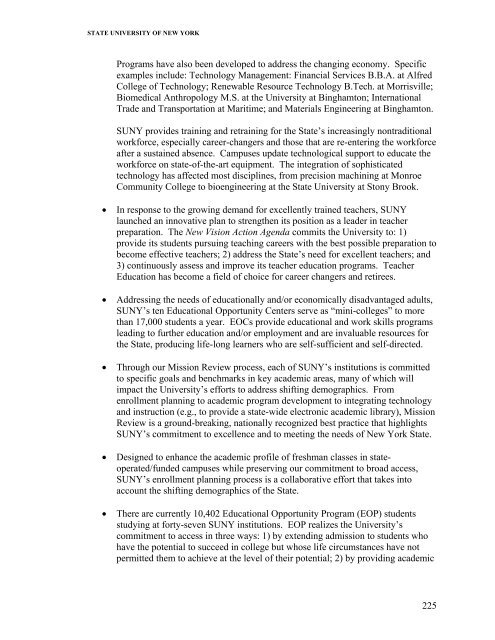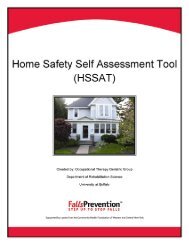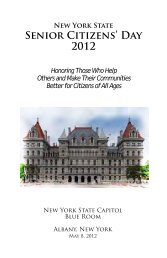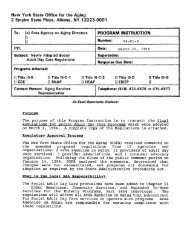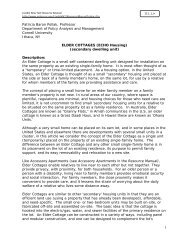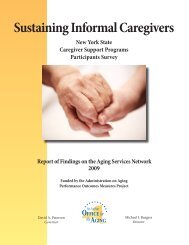White Paper - New York State Office for the Aging
White Paper - New York State Office for the Aging
White Paper - New York State Office for the Aging
- No tags were found...
You also want an ePaper? Increase the reach of your titles
YUMPU automatically turns print PDFs into web optimized ePapers that Google loves.
STATE UNIVERSITY OF NEW YORK<br />
Programs have also been developed to address <strong>the</strong> changing economy. Specific<br />
examples include: Technology Management: Financial Services B.B.A. at Alfred<br />
College of Technology; Renewable Resource Technology B.Tech. at Morrisville;<br />
Biomedical Anthropology M.S. at <strong>the</strong> University at Binghamton; International<br />
Trade and Transportation at Maritime; and Materials Engineering at Binghamton.<br />
SUNY provides training and retraining <strong>for</strong> <strong>the</strong> <strong>State</strong>’s increasingly nontraditional<br />
work<strong>for</strong>ce, especially career-changers and those that are re-entering <strong>the</strong> work<strong>for</strong>ce<br />
after a sustained absence. Campuses update technological support to educate <strong>the</strong><br />
work<strong>for</strong>ce on state-of-<strong>the</strong>-art equipment. The integration of sophisticated<br />
technology has affected most disciplines, from precision machining at Monroe<br />
Community College to bioengineering at <strong>the</strong> <strong>State</strong> University at Stony Brook.<br />
• In response to <strong>the</strong> growing demand <strong>for</strong> excellently trained teachers, SUNY<br />
launched an innovative plan to streng<strong>the</strong>n its position as a leader in teacher<br />
preparation. The <strong>New</strong> Vision Action Agenda commits <strong>the</strong> University to: 1)<br />
provide its students pursuing teaching careers with <strong>the</strong> best possible preparation to<br />
become effective teachers; 2) address <strong>the</strong> <strong>State</strong>’s need <strong>for</strong> excellent teachers; and<br />
3) continuously assess and improve its teacher education programs. Teacher<br />
Education has become a field of choice <strong>for</strong> career changers and retirees.<br />
• Addressing <strong>the</strong> needs of educationally and/or economically disadvantaged adults,<br />
SUNY’s ten Educational Opportunity Centers serve as “mini-colleges” to more<br />
than 17,000 students a year. EOCs provide educational and work skills programs<br />
leading to fur<strong>the</strong>r education and/or employment and are invaluable resources <strong>for</strong><br />
<strong>the</strong> <strong>State</strong>, producing life-long learners who are self-sufficient and self-directed.<br />
• Through our Mission Review process, each of SUNY’s institutions is committed<br />
to specific goals and benchmarks in key academic areas, many of which will<br />
impact <strong>the</strong> University’s ef<strong>for</strong>ts to address shifting demographics. From<br />
enrollment planning to academic program development to integrating technology<br />
and instruction (e.g., to provide a state-wide electronic academic library), Mission<br />
Review is a ground-breaking, nationally recognized best practice that highlights<br />
SUNY’s commitment to excellence and to meeting <strong>the</strong> needs of <strong>New</strong> <strong>York</strong> <strong>State</strong>.<br />
• Designed to enhance <strong>the</strong> academic profile of freshman classes in stateoperated/funded<br />
campuses while preserving our commitment to broad access,<br />
SUNY’s enrollment planning process is a collaborative ef<strong>for</strong>t that takes into<br />
account <strong>the</strong> shifting demographics of <strong>the</strong> <strong>State</strong>.<br />
• There are currently 10,402 Educational Opportunity Program (EOP) students<br />
studying at <strong>for</strong>ty-seven SUNY institutions. EOP realizes <strong>the</strong> University’s<br />
commitment to access in three ways: 1) by extending admission to students who<br />
have <strong>the</strong> potential to succeed in college but whose life circumstances have not<br />
permitted <strong>the</strong>m to achieve at <strong>the</strong> level of <strong>the</strong>ir potential; 2) by providing academic<br />
225


